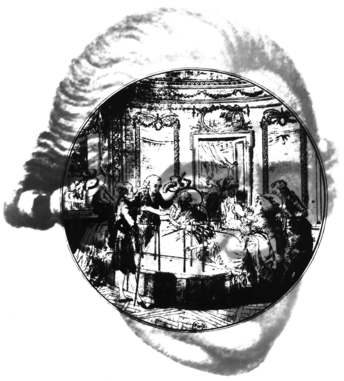Franz Anton Mesmer1734–1815
Mesmer set in train a branch of fringe medicine which proved to be the motive force for later dynamic psychology. “I named the property of the animal body that renders it liable to the action of heavenly bodies and of the earth animal magnetism.” Material magnetism, first elucidated by William Gilbert (1544-1603), was also considered to cast its subtle influence on the nervous system. Mesmer wrote of animal magnetism “that all bodies were, like the magnet, capable of communicating this magnetic principle; that this fluid penetrated everything and could be stored up and concentrated, like the electric fluid; that it acted at a distance”. Moreover, harnessing its forces could “cure nervous disorders directly and other disorders indirectly”. Mesmer, a Viennese physician, was attempting to provide a scientific explanation for some remarkable cures he had affected by requiring patients to grasp magnetized iron bars. He considered that this procedure resulted in restoring equilibrium between the patient’s state of animal magnetism and that prevailing in the environment. Later, cures were achieved without the use of magnetic bars, by rhythmic movements, by fixating, and by stroking the body. Despite his desire for academic respectability, Mesmer was ridiculed by his peers in Vienna, and moved to Paris in 1778. There the medical profession was as sceptical as it had been in Vienna, but in 1784 Mesmer’s claims were put to the test by two commissions, one of scientists and the other of physicians. The verdict of the commissions was that animal magnetism did not exist. The cures that undoubtedly did sometimes result from the treatment were said to be a consequence of the powers of imagination and imitation. In the course of their enquiries the commissioners carried out some of the first genuinely social psychological experiments, manipulating expectancies and controlling stimulus conditions, to show that the same effects could be produced in the absence of any magnetising fluid. Mesmer’s reputation was tarnished by this conclusion and he faded into obscurity, unlike the process he had uncovered, which was renamed mesmerism in his honour. Mesmerism was transformed into hypnotism by James Braid (1795-1860), who realized the potential of reduced states of consciousness for surgery. Mesmer is represented in combination with a contemporary portrayal of a mesmeric séance. He recommended treatment in séances which were conducted with much theatricality: patients, connected to one another by cords, would sit round a tub, or bacquet, of `magnetized’ fluid grasping iron rods that protruded from it. Mesmer and his assistants, called magnetizers, would pass amongst them occasionally stroking the body or the afflicted part. Patients often experienced convulsions during treatment, after which they were taken to a padded ‘crisis room’ where they usually passed into a trance before returning to their normal state. At about the same time of Mesmer’s magnetic therapy, a great interest and hope was being trusted in the possibility that electricity could be used for the treatment of a variety of diseases. Although the initial expectations of it as a universal panacea for all forms of illness (and the charlatanism of some of its practitioners), “electric medicine”, unlike Mesmer’s magnetism, eventually evolved in the modern of electric physiotherapy and diagnostic.
